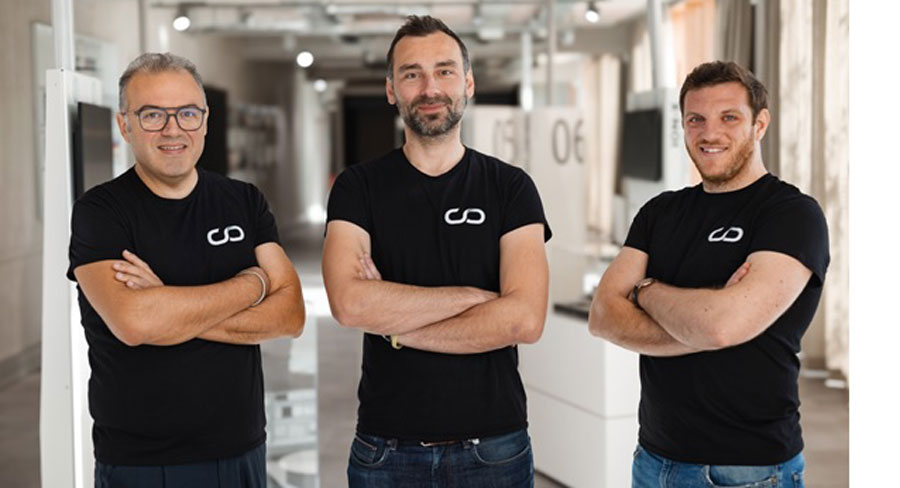News: Optoelectronics
26 November 2025
Silicon photonic interposer start-up NcodiN raises €16m in seed funding
NcodiN of Palaiseau, Paris, France (which was founded in 2023 to pioneer optical interposer technology with integrated nanolasers for next-generation computing) has secured €16m in an oversubscribed seed financing round.
The funding will propel NcodiN from R&D to industrial scale, enabling to develop product development, key engineering hires to support the industrialization of its technology in a CMOS pilot line on 300mm wafers, and the build-out of its supply chain and customer partnerships.
The equity round was led by MIG Capital, with participation from Maverick Silicon, PhotonVentures, and Verve Ventures, alongside continued support from existing backers Elaia, Earlybird, and OVNI.
Transforming the future of AI hardware
NcodiN is developing NConnect, a new generation of photonic interposers designed to overcome the ‘copper wall’ — the performance and energy limits of electrical interconnects that constrain AI systems. At its core is what is claimed to be the world’s smallest laser, enabling dense integration on silicon and unprecedented scalability without disrupting existing processor architectures.
This allows chip-makers to pack supercomputer-level power into a single processor, paving the way for faster, more efficient AI hardware. This fundraising will accelerate industrialization of the platform, including an industrial pilot to demonstrate compatibility with advanced packaging techniques.
With this round, NcodiN will also establish a Silicon Valley presence, expand its R&D capacity, and scale its team in preparation for large-scale manufacturing partnerships — bringing new technology to break the copper wall and redefine AI hardware performance.

Picture: NcodiN’s co-founders (from left to right) Fabrice Raineri, Bruno Garbin and Francesco Manegatti.
“We are delivering the missing piece for the industry’s most pressing challenge: enabling extremely high memory bandwidth to power the AI factories of tomorrow,” says CEO & co-founder Francesco Manegatti. “Our technology unlocks wafer-scale superchips by providing the most energy-efficient interconnects for networking across tens of chiplets — an essential component in the architectures everyone is chasing. As new generations of GPUs and AI accelerators emerge to keep pace with rapidly evolving GenAI algorithms, NcodiN is laying the photonic foundation that makes them possible,” he adds.
“Memory bandwidth has become a defining bottleneck in AI, with copper interconnects struggling to deliver the reach and efficiency required for next-generation systems,” comments Josh Mine of Maverick Silicon. “NcodiN’s photonic interposers unlock memory bandwidth and capacity beyond copper’s limits.”
Building on momentum
Over the past 18 months, NcodiN has demonstrated proof-of-concept nanolasers with record energy efficiency below 0.1pJ/bit, integrated nanodetectors, and full optical links, all on silicon. In parallel, it established an independent cleanroom that now serves as a hub for rapid prototyping and joint development with industry partners.
To strengthen its foundation, NcodiN has expanded its network of strategic advisors, welcoming, among others, Eli Yablonovitch, Gus Yeung and Peter de Dobbelaere.
Physicist Yablonovitch (professor in the Graduate School at UC Berkeley) is a pioneer of photonic crystals, and cofounder of Luxtera, Ethertronics, Luminescent, and Alta Devices. Yeung previously served as general manager at ARM, where he spent almost 20 years helping it to grow and establishing ARM as the reference design platform for today’s CPUs. He also served as CTO at Intel Foundry Services, driving the organizational and technological transformation required to serve world-class external customers. de Dobbelaere is a seasoned silicon photonics engineer, who played a central role in Luxtera’s rise as the first major success story in this industry.
“NcodiN is addressing the next big opportunity in silicon photonics, the silicon photonic interposer, which permits high-bandwidth communication in a multi-chip system, particularly for AI and machine learning,” says Yablonovitch. “To do this, they embed high-performance nanolasers in silicon, thereby combining physics elegance with manufacturability. This has the likelihood of revolutionizing all future large-scale cyber systems,” he adds.
“NcodiN is working at the center of the AI infrastructure market, a sector experiencing rapid, significant growth driven by the surging demand for generative AI, the proliferation of big data, advancements in specialized hardware like GPUs, and the widespread adoption of cloud computing,” says Dr Oliver Kahl, principal at MIG Capital. “The company’s ambitious team is shaping and empowering the future of computing to drive innovation across multiple industries,” he adds.
“At Elaia, we’ve been proud backers of NcodiN since it’s early days when it was a CNRS spin-off,” notes Clément Vanden Driessche, partner at Elaia. “While copper interconnects struggle to keep up, NcodiN is rewriting the rules with the world’s smallest laser and a revolutionary optical network. This isn’t just innovation; it’s the key to unlocking the next leap in AI and hyperscale performance.”









